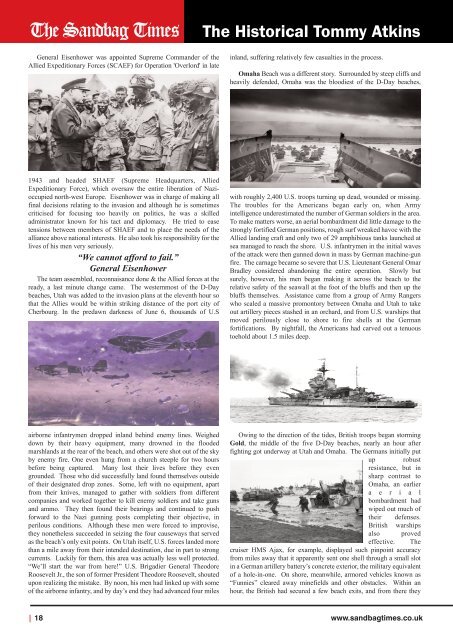The Sandbag Times Issue No: 21
The Veterans Magazine
The Veterans Magazine
Create successful ePaper yourself
Turn your PDF publications into a flip-book with our unique Google optimized e-Paper software.
<strong>The</strong> Historical Tommy Atkins<br />
General Eisenhower was appointed Supreme Commander of the<br />
Allied Expeditionary Forces (SCAEF) for Operation 'Overlord' in late<br />
inland, suffering relatively few casualties in the process.<br />
Omaha Beach was a different story. Surrounded by steep cliffs and<br />
heavily defended, Omaha was the bloodiest of the D-Day beaches,<br />
1943 and headed SHAEF (Supreme Headquarters, Allied<br />
Expeditionary Force), which oversaw the entire liberation of Nazioccupied<br />
north-west Europe. Eisenhower was in charge of making all<br />
final decisions relating to the invasion and although he is sometimes<br />
criticised for focusing too heavily on politics, he was a skilled<br />
administrator known for his tact and diplomacy. He tried to ease<br />
tensions between members of SHAEF and to place the needs of the<br />
alliance above national interests. He also took his responsibility for the<br />
lives of his men very seriously.<br />
“We cannot afford to fail.”<br />
General Eisenhower<br />
<strong>The</strong> team assembled, reconnaisance done & the Allied forces at the<br />
ready, a last minute change came. <strong>The</strong> westernmost of the D-Day<br />
beaches, Utah was added to the invasion plans at the eleventh hour so<br />
that the Allies would be within striking distance of the port city of<br />
Cherbourg. In the predawn darkness of June 6, thousands of U.S<br />
with roughly 2,400 U.S. troops turning up dead, wounded or missing.<br />
<strong>The</strong> troubles for the Americans began early on, when Army<br />
intelligence underestimated the number of German soldiers in the area.<br />
To make matters worse, an aerial bombardment did little damage to the<br />
strongly fortified German positions, rough surf wreaked havoc with the<br />
Allied landing craft and only two of 29 amphibious tanks launched at<br />
sea managed to reach the shore. U.S. infantrymen in the initial waves<br />
of the attack were then gunned down in mass by German machine-gun<br />
fire. <strong>The</strong> carnage became so severe that U.S. Lieutenant General Omar<br />
Bradley considered abandoning the entire operation. Slowly but<br />
surely, however, his men began making it across the beach to the<br />
relative safety of the seawall at the foot of the bluffs and then up the<br />
bluffs themselves. Assistance came from a group of Army Rangers<br />
who scaled a massive promontory between Omaha and Utah to take<br />
out artillery pieces stashed in an orchard, and from U.S. warships that<br />
moved perilously close to shore to fire shells at the German<br />
fortifications. By nightfall, the Americans had carved out a tenuous<br />
toehold about 1.5 miles deep.<br />
airborne infantrymen dropped inland behind enemy lines. Weighed<br />
down by their heavy equipment, many drowned in the flooded<br />
marshlands at the rear of the beach, and others were shot out of the sky<br />
by enemy fire. One even hung from a church steeple for two hours<br />
before being captured. Many lost their lives before they even<br />
grounded. Those who did successfully land found themselves outside<br />
of their designated drop zones. Some, left with no equipment, apart<br />
from their knives, managed to gather with soldiers from different<br />
companies and worked together to kill enemy soldiers and take guns<br />
and ammo. <strong>The</strong>y then found their bearings and continued to push<br />
forward to the Nazi gunning posts completing their objective, in<br />
perilous conditions. Although these men were forced to improvise,<br />
they nonetheless succeeded in seizing the four causeways that served<br />
as the beach’s only exit points. On Utah itself, U.S. forces landed more<br />
than a mile away from their intended destination, due in part to strong<br />
currents. Luckily for them, this area was actually less well protected.<br />
“We’ll start the war from here!” U.S. Brigadier General <strong>The</strong>odore<br />
Roosevelt Jr., the son of former President <strong>The</strong>odore Roosevelt, shouted<br />
upon realizing the mistake. By noon, his men had linked up with some<br />
of the airborne infantry, and by day’s end they had advanced four miles<br />
Owing to the direction of the tides, British troops began storming<br />
Gold, the middle of the five D-Day beaches, nearly an hour after<br />
fighting got underway at Utah and Omaha. <strong>The</strong> Germans initially put<br />
up robust<br />
resistance, but in<br />
sharp contrast to<br />
Omaha, an earlier<br />
a e r i a l<br />
bombardment had<br />
wiped out much of<br />
their defenses.<br />
British warships<br />
also proved<br />
effective. <strong>The</strong><br />
cruiser HMS Ajax, for example, displayed such pinpoint accuracy<br />
from miles away that it apparently sent one shell through a small slot<br />
in a German artillery battery’s concrete exterior, the military equivalent<br />
of a hole-in-one. On shore, meanwhile, armored vehicles known as<br />
“Funnies” cleared away minefields and other obstacles. Within an<br />
hour, the British had secured a few beach exits, and from there they<br />
| 18 www.sandbagtimes.co.uk


















